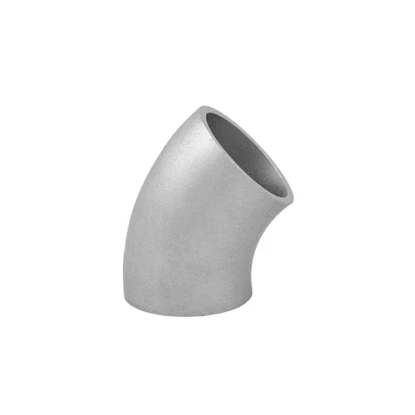Polishing Methods For Stainless Steel Elbows
To ensure 6 inch stainless steel 90 degree elbow exhibit better corrosion resistance, gloss, and service life during actual use, polishing is an essential step. This process not only improves appearance but also enhances material performance. This article will detail the necessity and methods of polishing stainless steel elbows and analyze its practical application value.
Why Polish Stainless Steel Elbows?
3 stainless elbow are used in many fields due to their excellent corrosion resistance and high-temperature resistance. However, after manufacturing, their surface may have a certain degree of roughness or oxide film, which can affect their aesthetics and performance. The main functions of polishing include:
-
Improving Corrosion Resistance: Polishing removes the oxide layer on the surface, making the stainless steel surface smoother, reducing the adhesion of corrosion sources, and thus extending service life.
-
Improving Appearance: A smooth, flawless surface enhances the visual appeal of stainless steel elbows, especially important in demanding applications.
-
Enhancing Hygiene: A smooth surface prevents the accumulation of bacteria or contaminants, which is crucial in applications such as the food and pharmaceutical industries.
Common Polishing Methods for Stainless Steel Elbows
Choosing the appropriate polishing method is crucial for stainless 90 degree elbow. Different polishing methods are suitable for different application needs and material specifications. Common polishing methods include:
1. Mechanical Polishing
Mechanical polishing is one of the most common polishing methods, typically using a polishing machine, polishing belt, or polishing wheel. This process removes surface irregularities through friction, making the surface smooth. It is suitable for most stainless steel elbows and effectively improves surface finish.
2. Chemical Polishing
Chemical polishing is a technique that uses a chemical reaction to smooth the surface of stainless steel. This process does not rely on mechanical force but uses an acidic solution to remove the surface layer. The advantage of chemical polishing is that it can uniformly remove surface substances and is suitable for stainless steel elbows with complex shapes.
3. Electrolytic Polishing
Electrolytic polishing uses an electric current to smooth the stainless steel surface, removing minute unevenness. Compared to mechanical polishing, electrolytic polishing allows for more precise control of surface quality and has a higher level of automation. Electrolytic polishing is a very suitable choice, especially for applications requiring a high degree of surface finish.
4. Manual Polishing
For some small-batch production or 304 stainless steel 90 degree elbow with special requirements, manual polishing remains a commonly used method. The surface is meticulously polished manually using polishing agents and tools to ensure it is free of defects and blemishes.
Criteria for Choosing Different Polishing Methods
The appropriate polishing method should be chosen based on the actual application scenario of the stainless steel elbow, the required surface finish, and production efficiency. Generally, mechanical polishing is suitable for mass production and applications with less stringent requirements, while chemical and electrolytic polishing are suitable for products with higher surface finish requirements. Hand polishing is mostly used for fine work and customized projects.
The Effect of Polishing Stainless Steel Elbows
After polishing, the surface of the 2.5 stainless steel 90 degree elbow is usually smoother and more lustrous. The effects of polishing are typically reflected in the following aspects:
-
More Uniform Surface: Polishing removes minor surface imperfections, making the surface of the 45 degree stainless steel elbow more uniform and enhancing its corrosion resistance.
-
Increased Service Life: By removing corrosion sources and oxide layers, polishing significantly extends the service life of the 1 1 2 stainless steel elbow.
-
Aesthetically Pleasing: Whether in industrial applications or high-end decorative settings, polished stainless steel elbows present a pleasing appearance, enhancing the overall visual effect of the installation.
Points to Note During Polishing
Several key issues require special attention during the polishing process of stainless steel elbows:
-
Polishing Compound Selection: Different types of stainless steel elbows may require different polishing compounds. Choosing the appropriate polishing compound not only ensures good results but also avoids damage to the material.
-
Operating Environment Control: Excessive friction or use of excessive chemical reagents should be avoided during polishing to prevent affecting the structure and properties of the stainless steel.
-
Quality Inspection: After polishing, a quality inspection is necessary to ensure the surface is free of scratches, defects, and other undesirable phenomena, guaranteeing that the product meets standards.
Industry Applications of Stainless Steel Elbow Polishing
Polishing steel 90 degree elbow has wide applications in many industries. For example, in the chemical industry, polishing effectively prevents corrosion and ensures long-term stable operation of equipment. In food processing and medical equipment, polishing is crucial because it reduces bacterial adhesion and ensures hygienic conditions. In the construction and decoration industry, the gloss and aesthetics of polished stainless steel elbows can also enhance the overall decorative effect.
Summary
Polishing stainless steel elbows is not only a means to improve their appearance but also an important step in improving their corrosion resistance and extending their service life. Various methods, such as mechanical polishing, chemical polishing, and electrolytic polishing, can be used to select the appropriate treatment method based on specific needs. When choosing a suitable polishing method, cost, efficiency, and effectiveness must be comprehensively considered to ensure that the stainless steel elbow performs optimally in practical applications.
